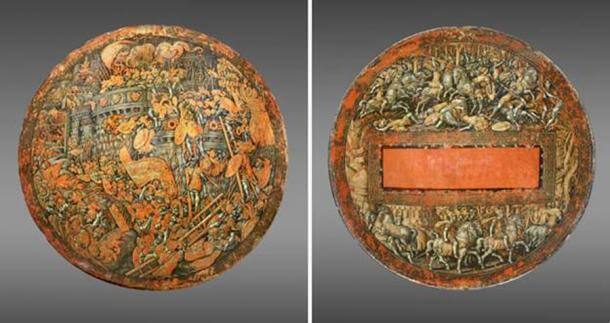 1
1

Arkaim and the texts of Rgveda about his builders
 25. 04. 2024
25. 04. 2024



 22. 12. 2021
22. 12. 2021

This remarkable Renaissance ceremonial shield was to be housed in the Adolf Hitler Museum in Linz, Austria. Now this symbolic piece of armor will return to the Czech Republic, where it was kept for centuries until the Nazi attack.
The shield was created around 1535 by the Italian sculptor and painter Girolamo di Tommaso da Treviso according to a design by Giulio Romano. The 61-centimeter shield tells the story of the Roman army's attack on New Carthage, in 209 BC The famous artist carefully applied "gesso" and pieces of gold to illustrate a detailed war scene.
The shield belonged to a collection of treasures looted by Nazi soldiers during World War II. It was transported across the Atlantic almost eight decades ago. Today, the shield is housed in the Philadelphia Museum of Art. Director Timothy Rub announced in a statement this week that the shield will now be returned to the Czech Republic, where it will be exhibited at the National Monuments Institute.

Shield depicting the conquest of New Carthage, made in Italy in 1535. Author: Girolamo di Tommaso da Treviso. (PhilaMuseum)
According to Smithsonian Mag, the shield was lost after World War II. Hynek Kmoníček, the Czech ambassador to the United States, said that this was a prime example of restitution. He added that legal cooperation between the USA and the Czech Republic should in the future serve as a model for an "international partnership in the return of looted art".
The creator of the symbolic shield, Girolamo di Tommaso da Treviso, sought to draw a parallel between the Roman victory at New Carthage in 209 BC and the military achievements of Charles V, Holy Roman Emperor in the 16th century from 1519 to 1556 AD In 1535 Charles claimed victory over the Muslim Ottoman Empire. Cities throughout Italy then celebrated the emperor. PMA Director Timothy Rub said in a statement that the shield was most likely used as a ceremonial prop during the post-war celebrations.
The shield was inherited for many generations, until it passed into the hands of Archduke Ferdinand. He kept the shield at the Konopiště chateau, his then seat near the town of Benešov in the Central Bohemian Region. The First World War was started on June 28, 1914 by nineteen-year-old Gavrilo Princip, who assassinated Archduke Francis Ferdinand in Sarajevo. This historic event also revolutionized the otherwise safe wandering of the ancient gable.

Konopiště Castle, Benešov, Czech Republic, 2011. Photo courtesy of the National Monuments Institute (NPÚ), Czech Republic (PhilaMuseum)
Konopiště u Benešova Chateau is a magnificent four-wing three-storey defensive structure, which was founded in the 13th century. After the annexation of the region by Hitler in 1939, the castle was seized by the new Czechoslovak government. According to the PMA, the shield was sent to Prague at this time, where it was waiting to be transported to Vienna. Adolf Hitler considered including it in his planned Das Führermuseum, a megalomaniac museum in Linz, Austria.
A statement from the Philadelphia Museum explains that most of the treasures from Konopiště Castle were returned to the Czech authorities. The shield was one of 15 items that have been missing for decades. Carl Otto Kretzschmar von Kienbusch, a collector of medieval weapons, who donated a collection to the Philadelphia Institution in which the shield was discovered, died in 1976.
The New York Times reports that in 2016, a team of art historians from the PMA and the Czech Republic discovered pre-World War II inventory lists. However, the question remains as to how he got from post-war confiscation by Allied forces in Europe into the private collection of Carl Otto Kretzschmar von Kienbusch in the USA.
In the apocryphal Philip's Gospel it is written that Jesus still accompanied three women on their behalf Marie - his mother, sister and fiancée. The apocryphal Philippian Gospel states that Jesus was still accompanied by three women by name Marie - his mother, sister and fiancée. Although this text seems symbolic, it is a real figure of his mother Mary, half-sister and wife of Mary of Bethany and free priestess Mary Magdalene.